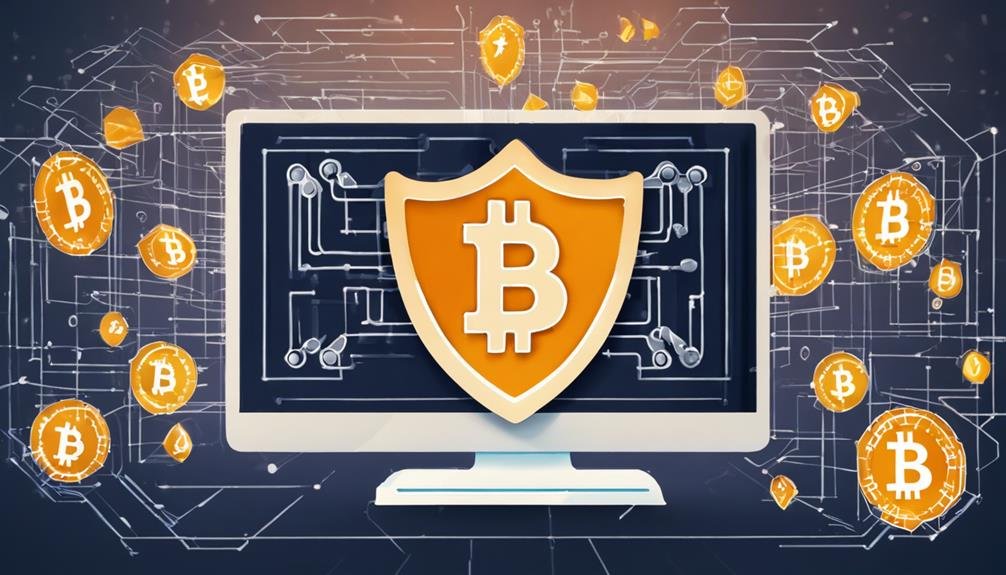Protecting your Bitcoin wallet from phishing attacks is akin to traversing a digital minefield. With cybercriminals constantly evolving their tactics, staying vigilant is paramount. But fear not, for there are effective strategies that can empower you to fortify your defenses and keep your digital assets safe. From identifying phishing emails to utilizing hardware wallets, each tactic is essential in warding off potential threats. Are you ready to take control and safeguard your Bitcoin holdings with these proven methods?
Table of Contents
Key Takeaways of 5 Best Strategies Against Phishing Attacks On Bitcoin Wallets
- Scrutinize the sender’s email for irregularities to avoid phishing.
- Implement Multi-Factor Authentication for enhanced wallet security.
- Educate about safe browsing habits to prevent phishing attacks.
- Use hardware wallets to keep private keys offline and secure.
Identify Phishing Emails Effectively

To effectively identify phishing emails, scrutinize the sender’s email address for irregularities or deceptive domain names. Phishing scams often use fake email addresses that mimic legitimate sources to deceive recipients. Be wary of emails requesting sensitive information like private keys or login credentials. Phishing emails may also contain suspicious attachments or links that can lead to phishing websites that steal your crypto assets.
Additionally, watch out for fake social media profiles that may be used in phishing attempts to gather information about you. An email exhibiting unusual language or tone could signify a phishing scam. Implementing two-factor authentication adds an extra layer of security against phishing attacks by requiring a secondary verification form to access your accounts.
Implement Multi-Factor Authentication

Implementing Multi-Factor Authentication enhances the security of your Bitcoin wallet by requiring multiple credentials for access. MFA is an additional protection against unauthorized access attempts, especially in the face of prevalent phishing threats targeting login credentials. Typically, MFA combines elements such as something you know (like a password), something you have (such as a smartphone for receiving verification codes), and something you are (like biometric data). Integrating MFA into your Bitcoin wallet security measures dramatically reduces the risk of falling victim to password theft and sophisticated phishing attacks.
Using MFA is a recommended practice to safeguard your digital assets from malicious actors seeking to exploit vulnerabilities in traditional password-based systems. This security measure fortifies your defenses and provides peace of mind, knowing that your Bitcoin holdings are better protected against potential breaches. Take the proactive step of implementing Multi-Factor Authentication today to bolster the security of your Bitcoin wallet.
Educate About Safe Browsing Habits

Strengthen your defenses against potential threats by educating yourself and others on safe browsing habits, particularly protecting your Bitcoin wallet. When dealing with cryptocurrency exchanges or managing digital wallets, it’s essential to stay vigilant against phishing and crypto scams. To avoid falling victim to these malicious attacks, practice secure browsing practices. Use secure browsers that employ SSL encryption to safeguard your sensitive information.
Always look for HTTPS and a lock sign in the website URL, indicating encrypted connections. Verify the secure site seal before entering personal or financial details to prevent falling prey to fake websites. By adhering to these secure browsing habits, you can greatly reduce the risk of becoming a target of phishing scams and enhance your Blockchain Security. Remember, a proactive approach to secure browsing is vital in safeguarding your cryptocurrency assets.
Regularly Update Security Software

Regularly updating your security software is essential for fortifying your defenses against evolving phishing techniques and vulnerabilities in safeguarding your Bitcoin wallet. By keeping your security software up to date, you guarantee it has the latest patches and updates necessary to counter new threats effectively. Outdated software may need more essential security enhancements critical in combating the constantly evolving phishing attack methods cybercriminals use to steal sensitive information from cryptocurrency users.
Failure to update your security software regularly can leave your Bitcoin wallet vulnerable to security breaches through phishing attempts. These updates are critical in strengthening your defenses and reducing the risk of falling victim to malicious attacks. Remember, staying proactive in updating your security software is a fundamental step in minimizing the vulnerabilities that can be exploited by cybercriminals targeting cryptocurrency users. Be diligent in applying these patches to maintain a secure environment for your Bitcoin transactions.
Use Hardware Wallets for Added Security

Utilizing hardware wallets enhances the security of your Bitcoin holdings by securely storing private keys offline, effectively safeguarding against phishing attacks and unauthorized access. Hardware wallets, such as Ledger and Trezor, offer an extra layer of security compared to online wallets. Here are four reasons why hardware wallets are a secure method to protect against phishing attacks:
- Hardware wallets keep private keys offline, minimizing the risk of unauthorized access.
- These wallets are specifically designed to protect against phishing attacks, ensuring the safety of your digital assets.
- By securely generating and storing private keys, hardware wallets reduce exposure to potential phishing attempts.
- Using a hardware wallet decreases the likelihood of falling victim to phishing scams targeting online wallets, providing a secure way to store and access cryptocurrencies.
Frequently Asked Questions
What Is the Most Effective Solution to the Phishing Attacks?
To bolster your defenses against phishing attacks, activate email verification, enable two-factor authentication, utilize hardware wallets, employ multisig protection, opt for offline storage, implement biometric authentication, consider token authentication, verify QR codes, store in cold storage, and integrate a password manager.
How Do I Recover My Money From a Scammer Through Bitcoin?
To recover money from a scammer through Bitcoin, consider legal action, use investigative methods for scammer identification, involve law enforcement, track assets with blockchain analysis, explore recovery options on exchanges, and utilize recovery services or technology solutions.
How Do I Secure My Bitcoin Wallet?
To secure your Bitcoin wallet effectively, utilize hardware wallets for enhanced protection. Enable 2FA and strong passwords, opt for cold storage (a method of storing Bitcoin offline, away from potential online threats) and paper backups, update software regularly, avoid public Wi-Fi, use VPNs, secure email, and consider biometric authentication for added security.
What Can Reduce the Risk of a Phishing Attack?
To reduce the risk of a phishing attack, use email filters, activate two-factor authentication, enhance security awareness, perform regular updates, create strong passwords, verify links, and consider multi-signature wallets (which require multiple private keys to authorize a Bitcoin transaction, thereby adding an extra layer of security), opt for hardware wallets, transact through cryptocurrency exchanges, and utilize anti-phishing software.
Conclusion
In summary, safeguarding your Bitcoin wallet from phishing attacks requires vigilance and proactive measures. By implementing the 5 best strategies outlined above and staying informed, you can considerably reduce the risk of falling victim to malicious actors. Each update to your security protocols is a step towards a more secure digital future. Protecting your digital assets is paramount in this ever-evolving landscape of cyber threats. Stay secure, stay vigilant, and keep your Bitcoin as safe as Fort Knox.



